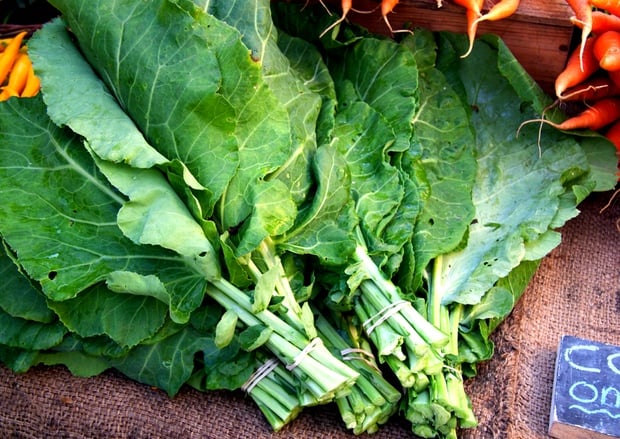When someone mentions Southern cuisine, the dishes that spring to mind–fried chicken, grits, biscuits and gravy–don’t exactly scream “healthy.” Luckily, collard greens, the trusty vegetable staple, are an exception. “Like most dark green veggies, they pack a hefty nutrient punch,” says registered dietitian Rima Kleiner.
Collards are a member of the cruciferous family, which includes popular vegetables such as kale, broccoli, Brussels sprouts, and cabbage. But, research has proven that steamed collard greens have equal–if not better–cholesterol-lowering properties than their leafy relatives.
Kleiner adds that they’re extremely low in calories (35 calories in half a cup of cooked greens) and are rich in folate, calcium, dietary fiber, and vitamins E, A, K, and C. Thanks to their many nutrients, collard greens have been associated with cancer prevention, detox support, anti-inflammatory properties, heart health, and digestive support.
The only problem you might have with collard greens is choosing from the myriad ways to cook them. Read on for a guide to choosing, storing, and cooking collards.
How to select: Choose greens with firm, vibrant green leaves for maximum freshness and highest-quality nutrients, says Kleiner. Avoid greens that have yellowed or browned.
How to store: Collards keep for three to five days if stored in a plastic bag in the produce drawer of the refrigerator. “Try to remove as much air as possible from the plastic bag,” says Kleiner.
How to prepare: Rinse the greens under cold water. Chop or cut the leaves and steams. Let sit for a few minutes before cooking.
How to cook: Collard greens taste great when lightly steamed for five minutes or sautéed with some olive oil and seasoning, Kleiner says. They’re so versatile, though, that they work great tossed into boiling pasta water or soups at the last minute. However, Kleiner cautions not to overcook collard greens–that’s when that bitter taste becomes overbearing.
Recipes to try: Kleiner loves the way her mother-in-law prepares collard greens. Sauté diced onion and sweet potato that’s been microwaved for two to three minutes before in olive oil. Add collard greens, broth, and cumin and simmer until greens are cooked.
Easy Chicken and Veggie No-Cheese Pizza


















